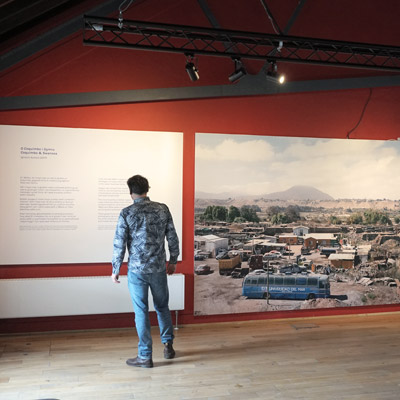Solo Exhibition
Coquimbo & Swansea
National Waterfront Museum
Swansea
July-November 2017
—
Site-specific installation of photographs and texts from series Coquimbo & Swansea, part of Copper Geographies.
From the late 1820s, copper ore was extracted from the Region of Coquimbo, northern Chile and smelted in the Lower Swansea Valley, Wales. Copper was mined from remote sites and brought by mule to Las Compañías, one of Chile’s first industrial metallurgical centres and where smelting processes had been established.
The ore and partly-smelted copper was shipped to the Lower Swansea Valley to be refined. The valley was heavily contaminated for more than two centuries, until the 1960s and 1970s when conservation work was carried out to reclaim polluted land.
These geopolitical tensions remain hidden in the photographs. By bringing these landscapes together, the artist wishes to reclaim historical connections and invites the viewer to imagine what is no longer there.
Robert Protheroe-Jones, Principal Curator of Industry at the Museum suggests: The Chili block found in the wreck of the S.S. Lapwing off the Isle of Wight in the English Channel. This steam ship sank on 1 July 1872 on a voyage from Liverpool to Rotterdam. Its cargo comprised Chili blocks, most of which were inscribed “Urmeneta y Guayacan”, and smaller ingots inscribed “Logan”.
The Chili blocks would have been smelted in the works of Jose Urmeneta & Company at Guayacan, Chile. They weighed up to 180kgs; the example acquired by the Museum weighs 70kgs. Chili blocks formed a major import to the south Wales copper smelting industry in the later nineteenth century as the industry changed increasingly from smelting ore to completing the smelting of regulus and to the refining part-smelted copper. This block was the first opportunity that the Museum had had to acquire a typical example of a Chili block.
The “Logan ingots” weighed around 6kgs each and were of the standard shape and dimensions of ingots produced by UK smelting works. A similar ingot inscribed “PG&S” (Pascoe Grenfell & Sons of Swansea) is displayed adjacent to your exhibition, and further ingots, inscribed “V&S A” (Vivian & Sons of Swansea) and “CCC BS” (Cape Copper Company of Briton Ferry near Swansea, best selected) are displayed in the Transformations gallery of the Museum. The “Logan” ingots would have been produced in the Birkenhead, Liverpool copper refinery owned by Logan & Company’.
—
Artist talk
Saturday, 1 July, 11.30am at the National Waterfront Museum
Supported by National Waterfront Museum, Wales and Arts and Humanities Research Council (AHRC)
Download catalogue with written contributions by historians Dr Tehmina Goskar and minerologist Frank Vicencio Lopez published in conjunction with the exhibition – Welsh and English versions
Link to Exhibition, National Waterfront Museum
